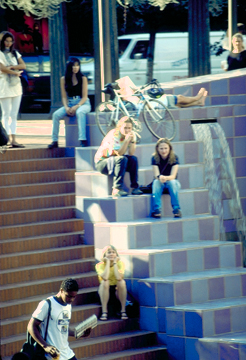What Makes a Place Great?
The new issue of the Making Places e-newsletter from the Project for Public Spaces tells us--
Over the past 30 years Project for Public Spaces has evaluated more than 1,000 public spaces, and informally investigated tens of thousands more. From all this we have discovered that most great places--whether a grand downtown plaza or humble neighborhood park--share four key qualities:
1. It is accessible and well-connected to other important places in the area.
2. The space is comfortable and projects a good image.
3. People are drawn to participate in activities there.
4. It is a sociable place where people like to gather, visiting it again and again.
Paying attention to these qualities can help you evaluate the public spaces in your own community, and make the changes that can transform them into great places.
Access and Linkages
 Pioneer Courthouse Square, Portland, Oregon. PPS photo.
Pioneer Courthouse Square, Portland, Oregon. PPS photo.You can easily judge the accessibility of a place by noting its connections to the surroundings--including the visual links. A great public space is easy to get to, easy to enter, and easy to navigate your way through. It's arranged in a way so you can see most of what is going on there, both from a distance and up close. The edges of a public space also play an important role in making it accessible; a row of shops along a street, for instance, is more interesting and generally safer to walk along than a blank wall or an empty lot. Accessible spaces are conveniently reached by foot and, ideally, public transit, and have a high parking turnover.
 (Photo: Pioneer Courthouse Square, Portland, OR)
(Photo: Pioneer Courthouse Square, Portland, OR)Questions to consider about Access and Linkages:
- Can you see the space from a distance? Is its interior visible from the outside?
- Is there a good connection between this place and adjacent buildings? Or is it surrounded by blank walls, surface parking lots, windowless buildings, or other alienating elements that discourage people from entering the area?
- Do occupants of adjacent buildings use the space?
- Can people easily walk to the place? Or are they intimidated by heavy traffic or forlorn streetscapes?
- Do sidewalks lead to and from the adjacent areas?
- Does the space function well for people with disabilities and other special needs?
- Do the paths throughout the space take people where they actually want to go?
- Can people use a variety of transportation options--bus, train, car, bicycle--to reach the place?
____________
For the rest of the piece, check out "What Makes a Place Great?" in the PPS e-newsletter.
These questions are useful guides to approaching land use and planning issues across the city, just like the questions posed by the Design Advocacy Group, and discussed in the blog entry "Speaking of effective citizen oversight and review of development, planning, and land use issues."



0 Comments:
Post a Comment
<< Home